US officials vow crackdown on looters
President George Bush has vowed zero tolerance for looters and other profiteers from the devastation left by Hurricane Katrina and said he would send in more troops if necessary.

In an unexpected interview on ABC television on Thursday, Bush also pledged maximum assistance for stricken areas of the US Gulf Coast, where hundreds were feared dead, and said Washington had not asked for any help from abroad.
Mississippi Governor Haley Barbour too vowed to take a hard line against looters who have descended on parts of his state in the wake of ferocious Hurricane Katrina, which devastated Gulf Coast towns in Mississippi, Louisiana and Alabama.
Looting “is a problem in some places,” Barbour told NBC television on Thursday. “We’re trying to deal with looters as ruthlessly as we can.”
In nearby New Orleans, Louisiana, authorities mounted a fierce battle against looters, as the mayor declared that battle a priority after bands of armed men roamed the hurricane-hit city late Wednesday in scenes of rising anarchy.
Armed men shot and wounded a National Guardsman outside the Superdome stadium in New Orleans and a helicopter also came under fire, a National Guard officer said on Thursday.
Truck held up
In another incident, armed men in the nearby city of Gretna held up a supply truck carrying food, water, medical supplies and pharmaceuticals, prompting officials to ask police and the US Coast Guard to help evacuate a 203-bed hospital.
“A National Guardsman was wounded by a gunshot. This happened outside the Superdome,” Colonel Pete Schneider of the Louisiana National Guard said on Thursday.
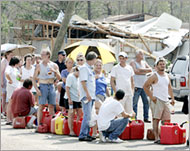 |
|
Saucier, Mississippi, residents in |
Schneider said the guardsman was being treated but was not in a life-threatening condition.
The Supredome had been used to accommodate up to 20,000 people left homeless after Hurricane Katrina struck on Monday.
Officials also said that one shot was fired at a huge twin-rotored Chinook helicopter which had been taking part in an operation to move hurricane refugees out of the stadium to other cities.
But Schneider said the aircraft had not been in any danger. “It takes more than a bullet to bring it down,” he said.
Looting spiralled so out of control on Wednesday that Mayor Ray Nagin ordered virtually the entire police force to abandon search-and-rescue efforts and focus on the brazen packs of thieves who have turned increasingly hostile.
Bush visit
President Bush will tour the hurricane devastated Gulf Coast region on Friday and has asked his father, former president George Bush Sr, and former president Bill Clinton to lead a private fund-raising campaign for victims, the White House said on Thursday.
White House press secretary Scott McClellan said Bush will survey the Alabama and Mississippi coast by helicopter, then go on to New Orleans.
He also will tour some locations on the ground.
Bush asked his father and Clinton to lead the fund-raising campaign after their successful similar efforts in the wake of the Asian tsunami that hit last December.
He made the request of them on Wednesday and the three planned a Thursday afternoon meeting in the Oval Office.
No security
“We have to close it down because we can no longer ensure the safety of our patients or our staff in that hospital,” said Steven Campanini, a spokesman for Tenet Healthcare Corp.
He said there were about 350 employees and between 125 to
150 patients inside the hospital, which is not flooded and
is functioning.
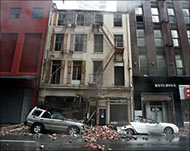 |
|
The death toll from the disaster |
Earlier, Nagin called for an all-out evacuation of the city’s remaining residents. Asked how many people died, he said: “Minimum, hundreds. Most likely, thousands.”
With most of the city under water, Army engineers struggled to plug New Orleans’ breached levees with giant sandbags and concrete barriers, and authorities drew up plans to clear out the tens of thousands of remaining people and practically abandon the below-sea-level city.
Nagin said there will be a “total evacuation of the city.
We have to. The city will not be functional for two or
three months.”
And he said people would not be allowed back into their homes for at least a month or two.
The military plans to increase the number of National Guard troops on duty in Louisiana and Mississippi from a combined 7400 to about 18,100, the senior commander in charge of military relief and rescue efforts said on Thursday.
Refugees
If the mayor’s death-toll estimate holds true, it would make Katrina the worst natural disaster in the US since at least the 1906 San Francisco earthquake and fire, which has been blamed for anywhere from about 500 to 6000 deaths.
Katrina would also be the nation’s deadliest hurricane since 1900, when a storm in Galveston, Texas, killed between 6000 and 12,000 people.
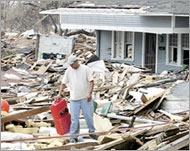 |
|
Reconstruction of the city is |
Those who took shelter from the storm in New Orleans’ Superdome stadium began a slow exodus on Wednesday, as the first of nearly 25,000 refugees left the miserable surroundings of the football stadium and were transported in buses to the Astrodome in Houston, 560km away.
Conditions in the Superdome had become horrendous: There was no air conditioning, the toilets were backed up, and the stench was so bad that medical workers wore masks as they walked around.
In Mississippi, bodies are starting to pile up at the morgue in hard-hit Harrison County. Forty corpses have been brought to the morgue already, and officials expect the death toll in the county to climb well above 100.
Tempers were beginning to flare in the aftermath of the storm. Police said a man fatally shot his sister in the head over a bag of ice in Hattiesburg, Mississippi.
Devastation
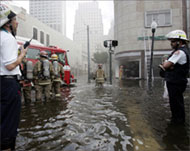 |
|
A hospital was evacuated due to |
The federal government dispatched helicopters, warships and elite SEAL water-rescue teams in one of the biggest relief operations in US history, aimed at plucking residents from rooftops in the last of the “golden 72 hours” rescuers say is crucial to saving lives.
As fires burned from broken natural-gas mains, the skies above the city buzzed with National Guard and Coast Guard helicopters frantically dropping baskets to roofs where victims had been stranded since the storm roared in with a 230-kph fury on Monday.
Atop one apartment building, two children held up a giant sign scrawled with the words: “Help us!”
Homeless
Hundreds of people wandered up and down shattered Interstate 10 – the only major freeway leading into New
Orleans from the east – pushing shopping carts, laundry racks, anything they could find to carry their belongings.
On some of the few roads that were still open, people waved at passing cars with empty water jugs, begging for relief.
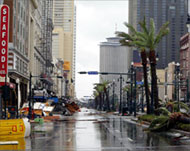 |
|
There are concerns about the |
Hundreds of people appeared to have spent the night on a crippled highway.
Nagin, whose pre-hurricane evacuation order got most of his city of a half a million out of harm’s way, estimated 50,000 to 100,000 people remained, and said that 14,000 to 15,000 a day could be evacuated in ensuing convoys.
“We have to,” Nagin said. “It’s not living conditions.”
He also expressed concern about people staying in the water: “People walking in that water with those dead bodies, it can get in your pores, you don’t have to drink it.”
Rescue plan
The Federal Emergency Management Agency was considering housing people on cruise ships, in tent cities, mobile home parks, and so-called floating dormitories.
The floodwaters streamed into the city’s streets from two levee breaks near Lake Pontchartrain a day after New Orleans thought it had escaped catastrophic damage from Katrina.
The floodwaters covered 80% of the city, in some areas six metres deep, in a reddish-brown soup of sewage, petrol and garbage.
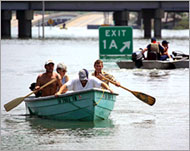 |
|
Residents are desperately trying |
Around midday, officials with the state and the Army Corps of Engineers said the water levels between the city and the lake had equalised, and water had stopped spilling into New Orleans, and even appeared to be falling. But the danger was far from over.
The Corps of Engineers said it planned to use heavy-duty Chinook helicopters to drop 6800kg bags of sand and stone as early as Wednesday night into the 150-metre gap in the failed floodwall.
But the agency said it was having trouble getting the sandbags and dozens of highway barriers to the site because the city’s waterways were blocked by loose barges, boats and large debris.